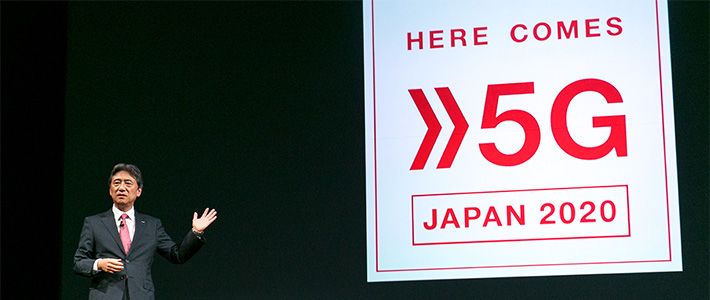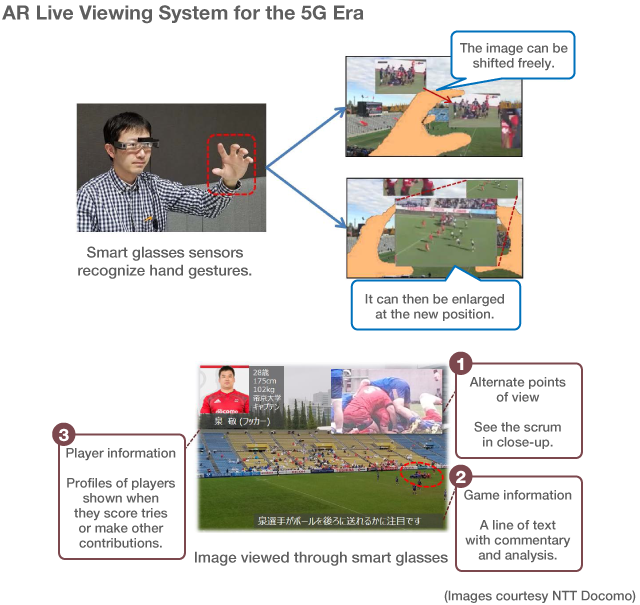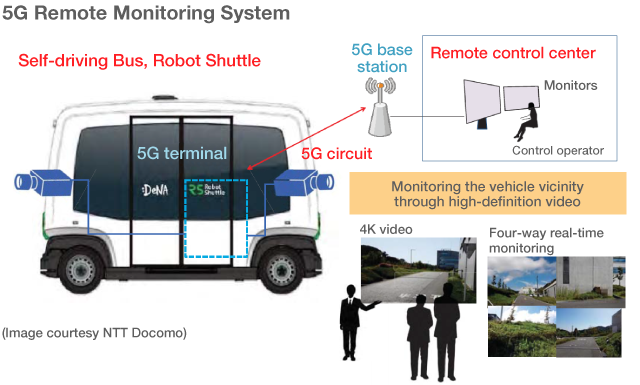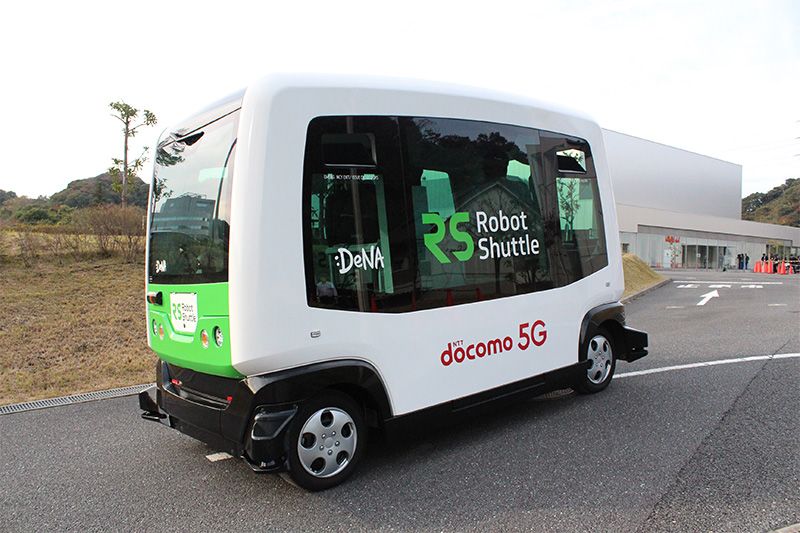
NTT Docomo Targets 5G Gold
Economy Science Technology- English
- 日本語
- 简体字
- 繁體字
- Français
- Español
- العربية
- Русский
A New Way to Watch Sports
As a soccer fan, I imagine what it might be like to watch a match in the summer of 2020.
Japan’s under-23 soccer team has reached the Olympic final for the first time ever. The Olympic Stadium—completed a few months earlier in Shinjuku, Tokyo—is filled with fans eager to cheer their team on.
Unlike a familiar stadium scene today, fans’ eyes are not fixed on the field. They glance back and forth between the field and their tablet computers and smartphones. The ultrahigh-definition screen displays the game in real time, but the point of view or the players shown differs by device. (Assuming prices fall, it will be possible to view 4K and 8K video on tablets and smartphones). Multiple video streams are transmitted based on the preferences of users. One fan follows the player who shoots, another the goalkeeper who blocks the shot, and a third watches a bird’s eye view of the field.
An even bigger surprise is people outside the stadium simultaneously watching multiple video streams. At public viewing areas around the city, fans gathered before giant screens are also following the game from different points of view on tablet computers and smartphones and are cheering loudly.
All of this could be made possible by fifth-generation mobile networks, the upcoming new telecommunications standard.
 Development of NTT Docomo’s augmented reality live viewing system for the 5G era. A trial event was held at a Top League rugby game in December 2017.
Development of NTT Docomo’s augmented reality live viewing system for the 5G era. A trial event was held at a Top League rugby game in December 2017.
Returning to the present reality, one 5G feature is the ability to view multiple high-definition video streams through mobile wireless networks that could previously only be transmitted by multichannel satellite broadcasts.
While specifications have yet to be defined in detail, work is under way to complete an international 5G standard by 2020. The consensus view is that 5G will far exceed the capabilities of existing mobile phone networks to transmit and receive large quantities of data at high speeds with very little latency. As high-speed communication 10 to 100 times current rates will be possible, 5G service will open the door to high-definition video streams and the instantaneous processing of big data. Unlike current mobile phones, where connections are difficult to establish in crowded areas, 5G will permit the simultaneous connection of 1 million devices per square kilometer.
This technological innovation has the potential of eliminating the firm wall that clearly separates radio-frequency-based broadcasting and telecommunications through regulating law, required licenses, and operator. Some broadcasters, fearing that the start of 5G service represents a life-or-death challenge, are already exploring new business models.
Race for the Prize
NTT Docomo has its eye on the Tokyo Olympic Games, but is not the only player interested in commercializing 5G service. The world’s leading mobile phone companies are working furiously behind the scenes in their efforts to win the gold medal of being first to offer commercial service in their respective home territories.
Seven companies currently form the top group: AT&T and Verizon in the United States; KT in South Korea; the Chinese trio of China Mobile, China Telecom, and China Unicom; and Japan’s NTT Docomo.
The two US companies have announced plans to begin providing 5G service throughout the United States as early as 2018. While 5G, this service will not be a mobile wireless network. Rather, it will be based on fixed wireless devices placed in offices and homes. In many Japanese homes, broadband access is provided by Wi-Fi access points linked to a fiber-optic network. Since the United States does not have a widespread fiber-optic network due to its geographic expanse, it will use a wireless network instead. As it is not actually a mobile wireless network, many observers are discounting these plans from the race to be the first mobile 5G operator.
NTT Docomo was quick to announce plans to begin commercial mobile 5G service in time for the Tokyo Olympics in 2020. The three Chinese companies are preparing to invest around ¥5 trillion in infrastructure for 5G service by 2020, and commercial service is expected to begin around that time.
KT of South Korea appears strongly committed to achieving a global first. It initially adopted the same launch schedule as NTT Docomo, but suddenly changed its policy in early 2017 and announced it would begin 5G service one year ahead of schedule in 2019. The Korea Economic Daily reports that this change was influenced by the decision that it could not fall behind Japan and China in the 5G race.
NTT Docomo also has domestic rivals. KDDI and SoftBank, Japan’s second- and third-largest mobile network operators, are now showing an interest in 5G.
Nakamura Takehiro, head of NTT Docomo’s 5G promotion office, maintains the company’s public stance of launching high-speed and high-capacity communications where it is most needed in 2020. Service areas will be the vicinity of Olympic and Paralympic facilities and prefectural capitals that are essential to regional revitalization. On January 19, however, Nokia, the Finnish communications equipment maker, announced that it had reached an agreement with NTT Docomo to supply it with 5G infrastructure equipment, indicating that preparations for 5G service are well under way. It would not be surprising if NTT Docomo changes its strategy and announces an earlier launch date so as not to fall behind its rivals. This may cause the company to restrict the size of the initial service area.
Why Does NTT Docomo Want to Be First?
Why is NTT Docomo so determined to be world first in launching 5G service?
The company has consistently built on its impressive technological capabilities, which date back to when it was a public corporation. It took the lead in establishing international standards and in launching commercial service for 1G (analog mobile phones), 2G (digital mobile phones), and 3G (W-CDMA/HSPA). This pioneering strategy then wavered with the arrival of 4G (LTE/LTE-Advanced). At the time, huge mobile phone markets were developing in emerging economies with large populations like China and India, and Japanese manufacturers were losing competitiveness in both infrastructure and mobile handsets. NTT Docomo decided there was no need to take the risk of not conforming to standards by launching a new service before consensus was formed and determined that it would be sufficient to join the lead group later.
With 5G, NTT Docomo is again aiming to be a trailblazer. Given the increasingly overcrowded frequency spectrum predicted for existing mobile wireless service, NTT Docomo has decided to rejoin the fray to win Japanese customers who favor leading-edge mobile service.
 In November 2017, NTT Docomo used 5G and other technology enabling low latency data transmission to synchronize a dance performance staged separately in Tokyo, London, and New York by the three members of the popular group, Perfume, which it live-streamed to the world through the Internet. (Photographs courtesy NTT Docomo)
In November 2017, NTT Docomo used 5G and other technology enabling low latency data transmission to synchronize a dance performance staged separately in Tokyo, London, and New York by the three members of the popular group, Perfume, which it live-streamed to the world through the Internet. (Photographs courtesy NTT Docomo)
Transforming Driving
At the dawn of the age of artificial intelligence and the Internet of Things, the arrival of 5G technology has the potential of greatly changing daily life and the world of business with its rapid, high-capacity transmission and massive simultaneous connectivity. There is no room to examine all the possibilities of 5G in this article, but one notable field for transformation is the automobile sector, which stands at a major turning point 130 years since the invention of the gasoline-powered internal combustion engine.
First, 5G technology is certain to be much used to supply information needed by driver assistance systems. Such information could encompass the latest road maps, natural disasters and accidents, and peripheral information about fallen objects on expressways and nearby pedestrians. The technology may also be used for convoy driving on expressways, where vehicles automatically follow the vehicle ahead of them in convoy formation, or as a radar to assist in parking vehicles.
Second, 5G technology should broaden the possibilities for tracing stolen vehicles and providing advanced ridesharing.
Third, the way people spend their time in automobiles will change. With 5G communication technology, it will be easy to hold high-quality videoconferences connecting hundreds of locations.
Fourth, it will become possible to perform complex operations remotely, a promising prospect not only for driving automobiles but also for dealing with accidents at mines or construction sites. The development of peripheral equipment and software has begun in earnest in related industries.
Since 5G technology is likely to find a broad range of applications, commercial service must be launched ahead of rival companies in order to capture and retain mobile wireless traffic that is expected to grow rapidly. As well as changing how people view the Olympic Games, these new services and applications may act as a catalyst for transformation of our daily lives and the business world. Developments surrounding 5G technology look likely to make headlines for some time to come.
 Robot Shuttle, a self-driving bus with 5G remote monitoring (Photograph courtesy NTT Docomo)
Robot Shuttle, a self-driving bus with 5G remote monitoring (Photograph courtesy NTT Docomo)
Company Profile
NTT Docomo is Japan’s leading mobile phone company with a domestic market share of 46% (as of September 30, 2017). It has led Japan’s Big Three mobile phone operators in new subscribers for the last three years. The current company is a successor to the Nippon Telegraph and Telephone Public Corporation. After privatization in 1985, the mobile phone business became a separate entity from the land line business in 1992. Before privatization it was the first corporation to launch automobile and mobile phone communications in 1979. NTT Docomo has driven the spread of mobile wireless communications as seen in the launch of i-mode in 1999, the world’s first mobile Internet service.
(Originally published in Japanese on January 26, 2018. Banner photo: NTT Docomo President Yoshizawa Kazuhiro discussing 5G plans at a meeting announcing new products in May 2017. © Rodrigo Reyes Marin/Aflo.)